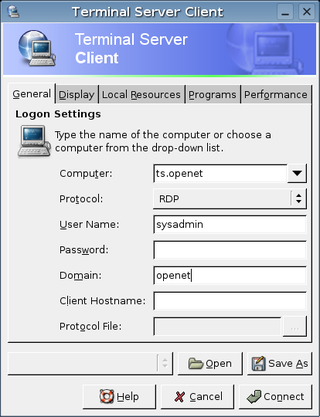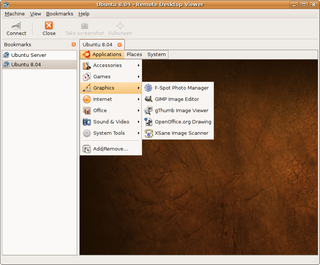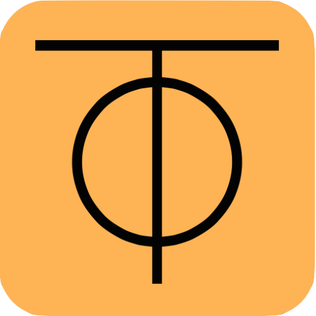
Irssi is an Internet Relay Chat (IRC) client program for Linux, FreeBSD, macOS and Microsoft Windows. It was originally written by Timo Sirainen, and released under the terms of the GNU GPL-2.0-or-later in January 1999.

VNC is a graphical desktop-sharing system that uses the Remote Frame Buffer protocol (RFB) to remotely control another computer. It transmits the keyboard and mouse input from one computer to another, relaying the graphical-screen updates, over a network. Popular uses for this technology include remote technical support and accessing files on one's work computer from one's home computer, or vice versa.
TightVNC is a free and open-source remote desktop software server and client application for Linux and Windows. A server for macOS is available under a commercial source code license only, without SDK or binary version provided. Constantin Kaplinsky developed TightVNC, using and extending the RFB protocol of Virtual Network Computing (VNC) to allow end-users to control another computer's screen remotely.
RFB is an open simple protocol for remote access to graphical user interfaces. Because it works at the framebuffer level it is applicable to all windowing systems and applications, including Microsoft Windows, macOS, the X Window System and Wayland. RFB is the protocol used in Virtual Network Computing (VNC) and its derivatives.
x11vnc is a Virtual Network Computing (VNC) server program. It allows remote access from a remote client to a computer hosting an X Window session and the x11vnc software, continuously polling the X server's frame buffer for changes. This allows the user to control their X11 desktop from a remote computer either on the user's own network, or from over the Internet as if the user were sitting in front of it. x11vnc can also poll non-X11 frame buffer devices, such as webcams or TV tuner cards, iPAQ, Neuros OSD, the Linux console, and the Mac OS X graphics display. x11vnc is part of the LibVNCServer project and is free software available under the GNU General Public License. x11vnc was written by Karl Runge.

Git is a distributed version control system that tracks versions of files. It is often used to control source code by programmers who are developing software collaboratively.
Synergy is a software application for sharing a keyboard and mouse between multiple computers. It is used in situations where several PCs are used together, with a monitor connected to each, but are to be controlled by one user. The user needs only one keyboard and mouse on the desk — similar to a KVM switch without the video.

Transmission is a BitTorrent client which features a variety of user interfaces on top of a cross-platform back-end. Transmission is free software licensed under the terms of the GNU General Public License, with parts under the MIT License.

tsclient is a discontinued frontend for rdesktop and other remote desktop tools, which allow remotely controlling one computer from another. It is a GNOME application. Notable visual options include color depth, screen size, and motion blocking.
VirtualGL (VGL) is an open-source software package that redirects the 3D rendering commands from Unix and Linux OpenGL applications to 3D accelerator hardware in a dedicated server and sends the rendered output to a (thin) client located elsewhere on the network. On the server side, VirtualGL consists of a library that handles the redirection and a wrapper program that instructs applications to use this library. Clients can connect to the server either using a remote X11 connection or using an X11 proxy such as a Virtual Network Computing (VNC) server. In case of an X11 connection some client-side VirtualGL software is also needed to receive the rendered graphics output separately from the X11 stream. In case of a VNC connection no specific client-side software is needed other than the VNC client itself.

qBittorrent is a cross-platform free and open-source BitTorrent client written in native C++. It relies on Boost, OpenSSL, zlib, Qt 6 toolkit and the libtorrent-rasterbar library, with an optional search engine written in Python.
This page is a comparison of notable remote desktop software available for various platforms.

ThinLinc is a cross-platform remote desktop server developed by Cendio AB. The server software and the users' main desktops run on Linux. Clients are available for Linux, Windows, macOS, and a number of thin clients. A browser client using HTML5 technologies is also available.

Vinagre is a discontinued VNC, SSH, RDP and SPICE client for the GNOME desktop environment, it is superseded by GNOME Connections. Vinagre was included in GNOME 2.22. It has several features, like the ability to connect to multiple servers simultaneously and to switch between them using tabs, VNC servers browsing and bookmarking. In version 2.29, Vinagre added controlling frame compression, better scaling and color depth. Version 2.30 added improved SSH tunneling and better support for copy-paste features between client and server.

Jami is a SIP-compatible distributed peer-to-peer softphone and SIP-based instant messenger for Linux, Microsoft Windows, macOS, iOS, and Android. Jami was developed and maintained by the Canadian company Savoir-faire Linux, and with the help of a global community of users and contributors, Jami positions itself as a potential free Skype replacement.

Prey is a software and online platform for mobile device tracking, management, and protection available for laptops, tablets, and mobiles. The software and service is developed by the Chilean company Prey Inc., successor of the funding company Fork Ltd.
In computing, SPICE is a remote-display system built for virtual environments which allows users to view a computing "desktop" environment – not only on its computer-server machine, but also from anywhere on the Internet – using a wide variety of machine architectures.
X2Go is open source remote desktop software for Linux that uses a modified NX 3 protocol. X2Go gives remote access to a Linux system's graphical user interface. It can also be used to access Windows systems through a proxy.

ZeroTier, Inc. is a software company with a freemium business model based in Irvine, California. ZeroTier provides proprietary software, SDKs and commercial products and services to create and manage virtual software-defined networks. The company's flagship end-user product ZeroTier One is a client application that enables devices such as PCs, phones, servers and embedded devices to securely connect to peer-to-peer virtual networks.
RustDesk is a remote access and remote control software, primarily written in Rust, that enables remote maintenance of computers and other devices. The RustDesk client runs on operating systems such as Microsoft Windows, Apple MacOS, Apple iOS, Android and common Linux distributions. RustDesk has the aspiration to be an open-source alternative to remote desktop software such as TeamViewer or AnyDesk. As a result, RustDesk can function without relying on additional tools such as VPNs or port forwarding, even behind firewalls or NATs.










